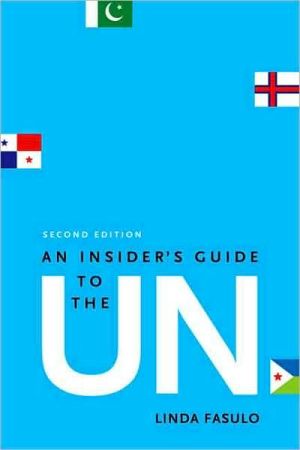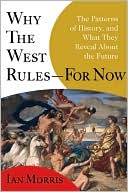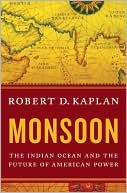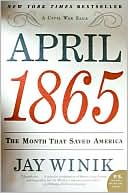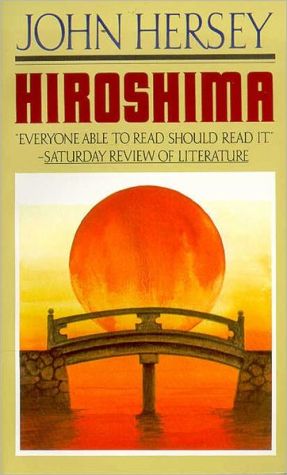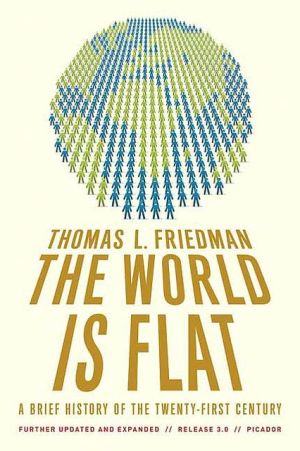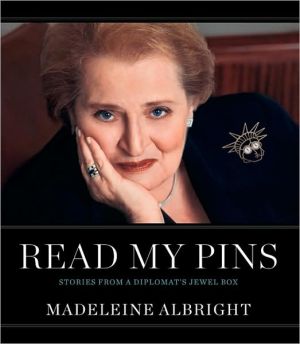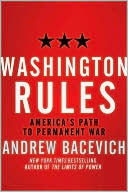An Insider's Guide to the UN
This completely revised edition of Linda Fasulo’s popular guide to the United Nations surveys the world body’s programs and activities, and covers key issues including human rights, climate change, counterterrorism, nuclear proliferation, peacekeeping, and UN reform. It also offers guidelines for setting up a Model UN.\ \ "No one knows the big picture and inner workings of the UN better than Linda Fasulo. This book is a must-read for anyone interested in international...
Search in google:
This completely revised edition of Linda Fasulo’s popular guide to the United Nations surveys the world body’s programs and activities, and covers key issues including human rights, climate change, counterterrorism, nuclear proliferation, peacekeeping, and UN reform. It also offers guidelines for setting up a Model UN."No one knows the big picture and inner workings of the UN better than Linda Fasulo. This book is a must-read for anyone interested in international affairs."—Tom Brokaw, NBC News"With fine journalistic clarity, the author leads readers through the complex organizational structure of the United Nations, shedding light on its mission, evolution, and controversies."—Christine C. Menefee, School Library Journal "The indispensable source on the United Nations for everyone from students to diplomats. I keep it handy on my desk."—Joseph S. Nye, Kennedy School of Government, Harvard University Library Journal Former UN ambassador Richard Holbrooke has called the UN "the flawed but indispensable institution." These two books illustrate what he meant. NPR correspondent Fasulo has written an overview for lay readers of the myriad activities under the UN umbrella. Most of her attention is given to topics that appear in the news frequently, such as the Security Council, General Assembly, and peacekeeping operations. Shorter chapters cover social and economic development, environmental programs, weapons of mass destruction, globalization, and drug traffic. In trying to cover many agencies, she has made the entries too brief to provide an accurate impression of all that the UN does in these areas. Anyone who has ever sent or received mail from abroad, bought an imported product, or flown in a commercial airliner has benefited from one or more UN agencies. Her intended readers are those totally unfamiliar with the UN, and they will likely find the book informative. But they will also need to consult John Alphin Moore Jr.'s and Jerry Pubantz's Encyclopedia of the United Nations. Alleyne (UCLA) has written a detailed analysis of one of the UN's functions, its Department of Public Information. In his earlier News Revolution, he discussed the importance of the media and public diplomacy in international affairs; here he focuses on the UN's public diplomacy efforts. Barred from propaganda activities and needing to maintain good relations with all member states, the department has necessarily avoided controversial topics. Descriptions of the agency and its programs are tediously bureaucratic in many places, the analytical discussions could have been more fully developed, and the framework used here is not in the mainstream of international relations analysis. However, recent events have led to increased discussion of public diplomacy, which makes this a useful work for collections specializing in media studies or international relations.-Marcia L. Sprules, Council on Foreign Relations Lib., New York Copyright 2003 Reed Business Information.
AN INSIDER'S GUIDE TO THE UN\ \ By LINDA FASULO \ Yale University Press\ Copyright © 2009 Linda Fasulo\ All right reserved.\ ISBN: 978-0-300-14197-9 \ \ \ Chapter One\ Introducing the UN \ [The UN] is an indispensable-and imperfect-forum that should be made more effective as a venue for collective action against terror and proliferation, climate change and genocide, poverty and disease. -Barack Obama, president of the United States\ The United Nations came into existence as a result of the most terrible war in history. During World War II, American president Franklin D. Roosevelt, British prime minister Winston Churchill, and the leaders of several other major combatant nations agreed that it was necessary to create a world organization that would help ensure the peace in future years. Their ideas are enshrined in the Preamble to the UN's Charter, which is one of its fundamental documents:\ We the peoples of the United Nations determined to save succeeding generations from the scourge of war, which twice in our lifetime has brought untold sorrow to mankind, and to reaffirm faith in fundamental human rights, in the dignity and worth of the human person, in the equal rights of men and women and of nations large and small, and to establish conditions under which justice and respect for the obligations arising from treaties and othersources of international law can be maintained, and to promote social progress and better standards of life in larger freedom, and for these ends to practice tolerance and live together in peace with one another as good neighbors, and to unite our strength to maintain international peace and security, and to ensure, by the acceptance of principles and the institution of methods, that armed force shall not be used, save in the common interest, and to employ international machinery for the promotion of the economic and social advancement of all peoples, have resolved to combine our efforts to accomplish these aims Accordingly, our respective Governments, through representatives assembled in the city of San Francisco, who have exhibited their full powers found to be in good and due form, have agreed to the present Charter of the United Nations and do hereby establish an international organization to be known as the United Nations.\ As the Preamble declares, the world's peoples, acting through their representatives, seek to create a just and prosperous world through common action. It could hardly be simpler, and yet, after more than six decades of trying, we still live amid global insecurity and, in many places, injustice and suffering. And the UN itself is far from simple. It straddles the globe, operating in almost every nation on earth, and it has a bewildering variety of offices, programs, and personnel. Let's begin, then, with some basic points and language that will appear throughout the book.\ The UN and the United States: It Takes Two to Tango\ Americans do not expect the UN to solve all the world's problems, but polls suggest that they would nevertheless like it to be a more effective partner in dealing with the forces and threats changing our world. The central role of the United States in creating and supporting the UN gives it a special place in UN affairs and has led many insiders to remark on the close and sometimes contentious relationship between the two entities. "The United Nations has no better friend than America," declares Secretary-General Ban Ki-moon. Arguing from national polls, he says that "most Americans want US foreign policy to be conducted in partnership with the UN. They understand that working together is in the best interest of the United States, the United Nations, and, most importantly, the peoples of the world."\ An eminent diplomat who served under the Clinton administration as US ambassador to the UN from 1999 to 2001 offers a similar analysis. "I need to underscore repeatedly that the UN is only as good as the US commitment," says Richard Holbrooke, who negotiated the Dayton Accords, ending the war in Bosnia in 1995. "The UN cannot succeed if the US does not support it."\ Another UN insider, speaking from a very different background, agrees with Holbrooke's assessment. Mark Malloch Brown spent many years running one of the UN's major agencies before becoming the deputy secretary-general during the last year of Kofi Annan's tenure as secretary-general. From this perch Malloch Brown gained a deep appreciation of the importance of the United States in almost all aspects of the UN's work. "You can't have an effective UN without very strong American engagement in the organization," he says. "The US has to be there in a strong leadership role."\ The US domestic political establishment has often included highly placed experts and advisers to who favor a go-it-alone foreign policy, and for them the UN sometimes seems a greater hindrance than help. The dominant view during the past half-century, however, has been for the US government to cooperate with and enable the UN as much as possible, as long as it doesn't threaten fundamental American interests. President Barack Obama is on record as saying that "no country has a greater stake in a strong United Nations than the United States. The United States benefits from a global institution intended to advance the rule of law, the peaceful resolution of disputes, effective collective security, humanitarian relief, development, and respect for human rights." Madeleine Albright, US secretary of state under President Clinton during his second term, argues that the United States does not have the choice of acting "only through the UN or only alone." Rather, she says, "we want-and need-both options. So in diplomacy, an instrument like the UN will be useful in some situations, useless in others, and extremely valuable in getting the whole job done." The UN can help make the world a better place, she continues, and this is to our advantage because we know that "desperation is a parent to violence, that democratic principles are often among the victims of poverty and that lawlessness is a contagious disease." Albright has stated it neatly: "We cannot be the world's policemen, though we're very good at it."\ Similar comments come from Zalmay Khalilzad, whom President Bush appointed US ambassador to the UN in 2007. He sees mutual advantages in the US-UN relationship: "The US is important for the UN. An effective US inside the UN is important for the UN, and an effective UN is important for the United States."\ Exactly What Is the United Nations?\ As the Preamble of the Charter declares, the world's peoples, acting through their representatives, seek to create a just and prosperous world through common action. But exactly what is the nature of this common effort? For one thing, it is not a form of "world government," as some may think. It is an organization of 192 sovereign nations. The world's people do not elect any of the executives who direct the organization, nor does the UN assess taxes on individuals. Furthermore, the UN can impose its will on nations only in rare and unusual circumstances, when great powers like the United States are prepared to back up the UN's actions with their own military and political might.\ The UN's limitations in these regards are not always well understood in the United States. Former ambassador Richard Holbrooke tells a story about a speaking engagement in Odessa, Texas-"George Bush country," as he puts it-when "some guy asked, 'What do you think about this world government thing?' I said there was no such thing, and he said, 'What about the UN, that's a world government, they are trying to take away our liberties.' And I said, 'Well, sir, that is just not true.' There are people out there who think the UN has that kind of power and insidious influence, and the truth is the exact opposite: the UN is too weak, not too strong. You start with a certain percentage of people completely misunderstanding the UN, criticizing it from the wrong point of view. Too strong is their fear when in fact too weak to be effective is the truth."\ The point about weakness is made also by analyst Jeffrey Laurenti, senior fellow at the Century Foundation, even as he emphasizes the organization's important role in shaping world opinion. He defines the organization as "a supra-political association incorporating all governments and drawing on their political authority. It is a weak membrane in terms of decision making and implementation but is nonetheless a political expression of a global sense of purpose and shared interests. The UN speaks to the aspirations of humankind. It commands public attention in most of the world as a place where world public opinion is developed and voiced and where global policy gets hammered out."\ Scanning the UN Flowchart\ One reason the UN is often misunderstood is that few except insiders really know its structure and organizing principles. One former US ambassador to the UN in the Clinton years, Nancy Soderberg, goes so far as to claim, "There is no such single thing as the UN." Rather, the UN "is 192 countries with different agendas and a whole collection of civil servants who work there, and it's all Jell-O. You can't say what the UN is because you touch one area and it comes out looking differently on the other side." Another former US ambassador, John Bolton, adds that people have a hard time understanding the organization because "they don't know what the different pieces do, and some of the humanitarian agencies, which do work well, get lost in the shuffle."\ A good beginning point for dissecting the UN is the accompanying flowchart, which lays out the basic structures and entities. At the top are the six principal organs, some of which are household names: the International Court of Justice (better known as the World Court), the Security Council (in which five selected countries have the right to veto any resolution they don't like), the General Assembly (which consists of delegates from all member nations of the UN), the Economic and Social Council (ECOSOC), the Trusteeship Council (which did its job so well it has lost its reason for being), and the Secretariat. With the exception of ECOSOC and the Trusteeship Council, these principal organs get considerable media coverage and are, in some ways, the most significant movers and shakers within the UN (see appendix A for a breakdown of UN groups).\ When we move to the second tier of organizations, the scene gets more complicated. Here we find a varied collection of entities and organizations, some of which are older than the UN itself and operate with almost complete independence from it. Best known to the public are the "Specialized Agencies," such as the United Nations Educational, Scientific and Cultural Organization (UNESCO), the World Health Organization (WHO), the World Bank, and the International Monetary Fund (IMF). Another group, called "Programmes and Funds," includes one very well known body, the United Nations Children's Fund (UNICEF), and several others that appear frequently in the news, like the United Nations Environment Programme (which monitors climate change and other environmental issues) and the United Nations High Commissioner for Refugees (UNHCR). Below them on the chart are "Other UN Entities," featuring one standout, the Human Rights Council, which meets in Geneva and receives heavy press coverage, and three others that play important but less publicized roles. The five research institutes likewise keep a low public profile.\ The "Related Organizations" contain such entities as the World Trade Organization, the International Atomic Energy Agency (IAEA), and two sets of commissions. The "Functional Commissions" include some that on first glance seem to poach on the ground of other entities. For example, the Commission on Narcotic Drugs seems to overlap the UN Drug Control Programme, on the left side of the chart. Similarly, the Commission on the Status of Women seems to overlap the UN Development Fund for Women. However, the overlap is more apparent than real in these two cases, because the Functional Commissions concentrate on policy, while the agencies are oriented more toward implementation. In addition we find the "Regional Commissions," which are among the least known of UN bodies. They set policy about economic development in the regions of Africa, Europe, Latin America and the Caribbean, Asia and the Pacific, and Western Asia.\ How It Works\ We now have a good schematic picture of the UN's structure. But this is only a beginning. When we think about these organizations in action, flowcharts aren't very helpful because they don't show how the parts interact or how effective or efficient they are. They don't show, for example, that regional blocs control most of the votes in the main deliberative body, the General Assembly. The blocs are invisible yet powerful actors on the UN stage. The flowchart also does not explain that although the "supporting organizations" sit below specific other organizations, they are not merely adjuncts of those organizations. On the contrary, many of the supporting organizations run their own affairs with little interference and, as critics have complained, with not much communication with the peer agencies, programs, or commissions with which they share interests.\ The fact that the UN is overseen by 192 member states, often with varying agendas, can contribute to a degree of administrative waffling and diplomatic theatrics. Brian Urquhart, who participated in creating the UN, argues, however, that the shortcomings have to be balanced against the strengths. "There's quiet diplomacy, which goes on twenty-four hours a day," he says. "There's the secretary-general and the Secretariat, who, contrary to general belief, are rather effective and not, incidentally, a great bloated organization.... The UN is not very efficient, I have to say, in some respects, because it's recruited from all over the world, and you have to work hard to get a common standard going, but it does work." He concludes, "The UN is like an insurance policy: you hate paying for it, but it's useful if something goes wrong."\ Secretary-General Ban Ki-moon emphasizes the unique position of the UN as an honest broker. "At the United Nations we have great convening power to find global solutions to our global problems." And problems there surely are, from terrorism and nuclear proliferation to worldwide hunger and disease, "to name just a few." These threats "cannot be approached," says the secretary-general, "as items on a list. The trick is to see them as part of a broader whole. In truth, solutions to one are solutions to all. The key is to see the interconnections among all the problems that come to our door at the UN."\ What's in It for Us?\ Putting aside international diplomacy, why should Americans care about the UN? Pressed to identify a specific UN-related item or service they have encountered recently, people might mention UNICEF trick-or-treat boxes and holiday cards. But is that all? The UN sets standards that affect us every day. "You may think that you have never benefited personally from the UN," says Madeleine Albright, "but if you have ever traveled on an international airline or shipping line or placed a phone call overseas or received mail from outside the country or been thankful for an accurate weather report-then you have been served directly or indirectly by one part or another of the UN system." For a global power like the United States, says Zalmay Khalilzad, the world body is a very important instrument that should be made as effective as possible and "reformed as we go forward so that it can maintain the confidence of people and countries around the world." Susan Rice, who became UN ambassador under President Obama, warns that the UN "is not a cure-all; we must be clear-eyed about the problems, challenges, and frustrations of the institution." But, she continues, it is also "a global institution that can address a tremendous range of critical American and global interests."\ Chapter Two\ Founding Documents \ [The UN is] immensely important because it represents legitimacy and international law, without which we'll all eventually go into the ditch. It represents a place where in emergencies you can actually do something ... that will be accepted even by people ... who would not accept an intervention by the US or any other single country. -Brian Urquhart, aide and adviser to UN secretaries-general, 1946-86\ As with any organization that exists in this ever-changing world, the UN cannot act according to an unchanging set of rules. It possesses two documents to guide its members. The first is the UN Charter, written in 1945, which functions as the Constitution does for the United States and, like the Constitution, has been amended over time to reflect changing needs. The second is the Universal Declaration of Human Rights, which is a manifesto of human dignity and value that remains as fresh and radical now as it was when adopted in 1948 (the Declaration is printed in appendix B).\ The Charter\ The Charter was signed on June 26, 1945, by fifty nations and entered into force several months later, on October 24. The chapters and articles constitute a treaty and are legally binding on the signatories. Article 103 of the Charter stipulates that if a member state finds that its obligations under the Charter conflict with duties under "any other international agreement," the state must place its Charter obligations first.\ (Continues...)\ \ \ \ \ Excerpted from AN INSIDER'S GUIDE TO THE UN by LINDA FASULO Copyright © 2009 by Linda Fasulo. Excerpted by permission.\ All rights reserved. No part of this excerpt may be reproduced or reprinted without permission in writing from the publisher.\ Excerpts are provided by Dial-A-Book Inc. solely for the personal use of visitors to this web site. \ \
AcknowledgmentsPrologueAbbreviations1An Overview12UN Founding Documents143The Secretary General and the Secretariat174The American Ambassadors335The Security Council396Peace Operations527The General Assembly688Coordinating to Fight International Terrorism799The UN Village9010Rights versus Sovereignty: The US and the International Criminal Court10011The Call for Reform10512UN Finances11413A Tour of UN Headquarters12514The Coup Against Boutros-Ghali13415UN Advocates, Donors, and Friends13916Keeping Tabs on How Nations Vote14517Making a Career at the UN14818Ecosoc15319Agencies, Programs, and Commissions15820Rule of Law and Human Rights16121Social and Economic Development16822Protecting the Biosphere and Its Inhabitants17823UN to the Rescue18324Nuclear, Biological, and Chemical Threats18825Guiding Globalization: How the UN Helps Make Things Work19126Drug Trafficking197Conclusion203App. AMembership of Principal United Nations Organs in 2002205App. BUniversal Declaration of Human Rights208App. CUN Member States215App. DHow to Set Up a Model UN Meeting221Sources229Further Reading231Index237
\ Library JournalFormer UN ambassador Richard Holbrooke has called the UN "the flawed but indispensable institution." These two books illustrate what he meant. NPR correspondent Fasulo has written an overview for lay readers of the myriad activities under the UN umbrella. Most of her attention is given to topics that appear in the news frequently, such as the Security Council, General Assembly, and peacekeeping operations. Shorter chapters cover social and economic development, environmental programs, weapons of mass destruction, globalization, and drug traffic. In trying to cover many agencies, she has made the entries too brief to provide an accurate impression of all that the UN does in these areas. Anyone who has ever sent or received mail from abroad, bought an imported product, or flown in a commercial airliner has benefited from one or more UN agencies. Her intended readers are those totally unfamiliar with the UN, and they will likely find the book informative. But they will also need to consult John Alphin Moore Jr.'s and Jerry Pubantz's Encyclopedia of the United Nations. Alleyne (UCLA) has written a detailed analysis of one of the UN's functions, its Department of Public Information. In his earlier News Revolution, he discussed the importance of the media and public diplomacy in international affairs; here he focuses on the UN's public diplomacy efforts. Barred from propaganda activities and needing to maintain good relations with all member states, the department has necessarily avoided controversial topics. Descriptions of the agency and its programs are tediously bureaucratic in many places, the analytical discussions could have been more fully developed, and the framework used here is not in the mainstream of international relations analysis. However, recent events have led to increased discussion of public diplomacy, which makes this a useful work for collections specializing in media studies or international relations.-Marcia L. Sprules, Council on Foreign Relations Lib., New York Copyright 2003 Reed Business Information.\ \ \ \ \ School Library JournalAdult/High School-With fine journalistic clarity, the author leads readers through the complex organizational structure of the United Nations, shedding light on its mission, evolution, and controversies. The "insider" of the title is not just Fasulo, an experienced UN correspondent, but also a number of frequently quoted former UN diplomats and staffers, including David Malone, John Negroponte, and Mark Malloch Brown. Primary documents include the Preamble, the Universal Declaration of Human Rights ("which remains as fresh and radical now as when it was adopted in 1948"), and key articles of the UN Charter. Fasulo shows that though it began as an organization to represent governments of countries, the UN is increasingly concerned with the welfare of individuals, whatever their nationality. She discusses influential leaders such as Secretary General Kofi Annan and topics such as globalization, drug trafficking, terrorism, and the biosphere. Sidebars, charts, and well-placed, black-and-white photographs break up the text, inviting browsing and providing detailed information on topics such as the UN response to the September 11 attacks. The chapter "Making a Career at the UN" is an interesting narrative from a career staffer about his early days, and "A Tour of UN Headquarters" would be useful to prospective visitors. This concise, highly readable volume is an invaluable and essential source of information for general readers, report writers, and Model UN delegates.-Christine C. Menefee, Fairfax County Public Library, VA Copyright 2004 Reed Business Information.\ \
